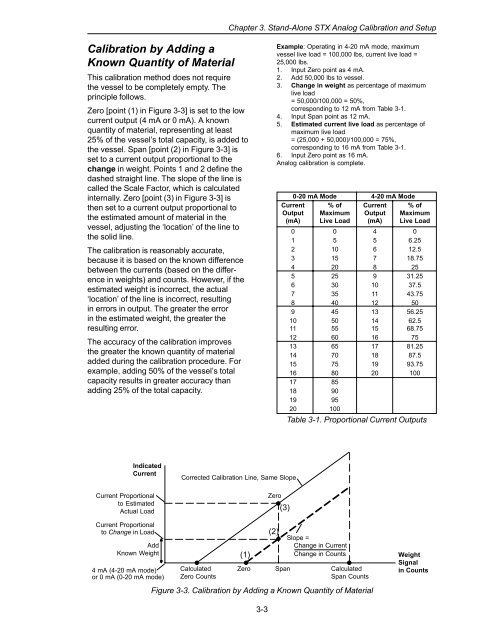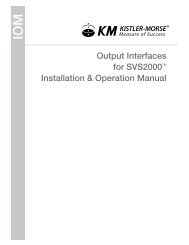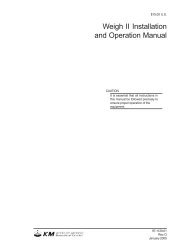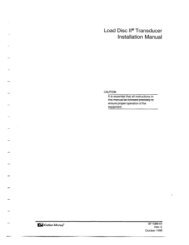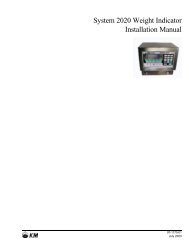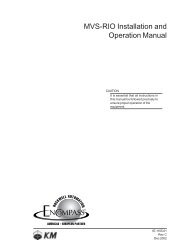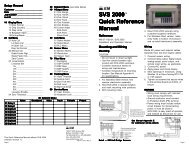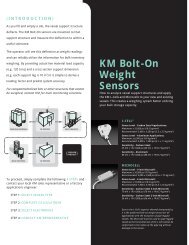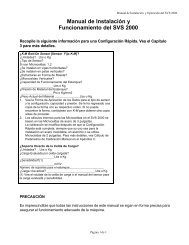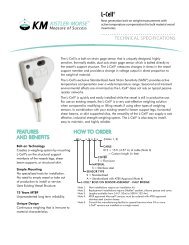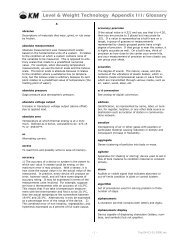STX Signal Transmitter Installation and Operation ... - Kistler-Morse
STX Signal Transmitter Installation and Operation ... - Kistler-Morse
STX Signal Transmitter Installation and Operation ... - Kistler-Morse
You also want an ePaper? Increase the reach of your titles
YUMPU automatically turns print PDFs into web optimized ePapers that Google loves.
Chapter 3. St<strong>and</strong>-Alone <strong>STX</strong> Analog Calibration <strong>and</strong> Setup<br />
Calibration by Adding a<br />
Known Quantity of Material<br />
This calibration method does not require<br />
the vessel to be completely empty. The<br />
principle follows.<br />
Zero [point (1) in Figure 3-3] is set to the low<br />
current output (4 mA or 0 mA). A known<br />
quantity of material, representing at least<br />
25% of the vessel’s total capacity, is added to<br />
the vessel. Span [point (2) in Figure 3-3] is<br />
set to a current output proportional to the<br />
change in weight. Points 1 <strong>and</strong> 2 define the<br />
dashed straight line. The slope of the line is<br />
called the Scale Factor, which is calculated<br />
internally. Zero [point (3) in Figure 3-3] is<br />
then set to a current output proportional to<br />
the estimated amount of material in the<br />
vessel, adjusting the ‘location’ of the line to<br />
the solid line.<br />
The calibration is reasonably accurate,<br />
because it is based on the known difference<br />
between the currents (based on the difference<br />
in weights) <strong>and</strong> counts. However, if the<br />
estimated weight is incorrect, the actual<br />
‘location’ of the line is incorrect, resulting<br />
in errors in output. The greater the error<br />
in the estimated weight, the greater the<br />
resulting error.<br />
The accuracy of the calibration improves<br />
the greater the known quantity of material<br />
added during the calibration procedure. For<br />
example, adding 50% of the vessel’s total<br />
capacity results in greater accuracy than<br />
adding 25% of the total capacity.<br />
Example: Operating in 4-20 mA mode, maximum<br />
vessel live load = 100,000 lbs, current live load =<br />
25,000 lbs.<br />
1. Input Zero point as 4 mA.<br />
2. Add 50,000 lbs to vessel.<br />
3. Change in weight as percentage of maximum<br />
live load<br />
= 50,000/100,000 = 50%,<br />
corresponding to 12 mA from Table 3-1.<br />
4. Input Span point as 12 mA.<br />
5. Estimated current live load as percentage of<br />
maximum live load<br />
= (25,000 + 50,000)/100,000 = 75%,<br />
corresponding to 16 mA from Table 3-1.<br />
6. Input Zero point as 16 mA.<br />
Analog calibration is complete.<br />
0-20 mA Mode 4-20 mA Mode<br />
Current % of Current % of<br />
Output Maximum Output Maximum<br />
(mA) Live Load (mA) Live Load<br />
0 0 4 0<br />
1 5 5 6.25<br />
2 10 6 12.5<br />
3 15 7 18.75<br />
4 20 8 25<br />
5 25 9 31.25<br />
6 30 10 37.5<br />
7 35 11 43.75<br />
8 40 12 50<br />
9 45 13 56.25<br />
10 50 14 62.5<br />
11 55 15 68.75<br />
12 60 16 75<br />
13 65 17 81.25<br />
14 70 18 87.5<br />
15 75 19 93.75<br />
16 80 20 100<br />
17 85<br />
18 90<br />
19 95<br />
20 100<br />
Table 3-1. Proportional Current Outputs<br />
Indicated<br />
Current<br />
Current Proportional<br />
to Estimated<br />
Actual Load<br />
Corrected Calibration Line, Same Slope<br />
Zero<br />
(3)<br />
Current Proportional<br />
to Change in Load (2)<br />
Add<br />
Known Weight<br />
4 mA (4-20 mA mode)<br />
or 0 mA (0-20 mA mode)<br />
Calculated<br />
Zero Counts<br />
(1)<br />
Zero<br />
Span<br />
Slope =<br />
Change in Current<br />
Change in Counts<br />
Calculated<br />
Span Counts<br />
Figure 3-3. Calibration by Adding a Known Quantity of Material<br />
Weight<br />
<strong>Signal</strong><br />
in Counts<br />
3-3


